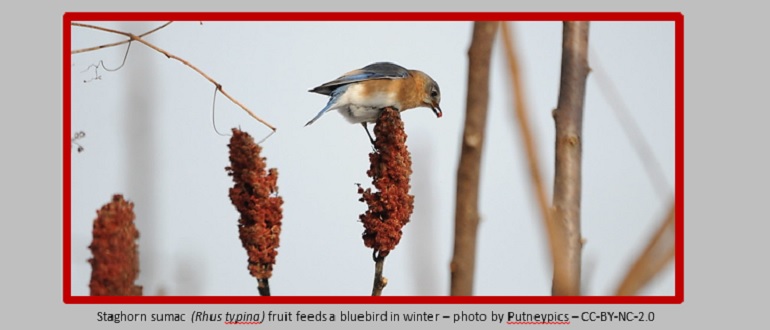GET TO KNOW
Michigan Native Sumac Shrubs
Sumac shrubs, well-known for their brilliant fall colors, also serve as a wintertime superfood for wildlife. The large and colorful, upright fruit clusters (known as drupes) cling to branches long after ripening and offer a nutritious and high fat content food for winter survival. In fact, it is estimated, by the American Forest Foundation, that as many as 100 different species of birds – plus most small woodland mammals – feed on sumac drupes.
FUN FACT – It is very important to “leave the leaves” in fall so that a natural layer of leaf litter provides wintertime shelter for the smallest of creatures. Sumacs are a host plant for the very adorable red banded hairstreak butterfly. This lovely little butterfly lays its eggs on fallen sumac leaves, and its caterpillars depend on a stable layer of the leaf litter for food, shelter, and winter survival. (Photo by Christina Butler CC-BY-2.0)

Like many fruit bearing shrubs, sumacs are year-round habitat superstars. In addition to their nutritious fruits, these dense and sturdy shrubs offer strong branches for shelter, broad leaf cover from summer sun, and bountiful summer flower clusters that attract bees, moths and butterflies.
In Michigan, there are four species of “regular” sumac shrubs that grow in upland areas and are classified as belonging to the Rhus genus of plants. These sturdy shrubs all have large pinnate leaves with up to 31 leaflets per leaf and bear upright, red fruit clusters. They are sun-loving plants that are tolerant of poor, dry and disturbed soils and are often one of the first plants to colonize a distressed area after a major disturbance (e.g.: fire or agriculture). In woodland areas, these shrubs are primarily found only along the margins where they share their spring flowers, fall colors, and winter drupes with all who pass by.
Rhus family sumac shrubs are generally considered non-toxic and have been widely valued for culinary and medicinal purposes throughout the world. Yet, there is also a well-known wetland shrub, commonly called “poison sumac”, that is somewhat poisonous to humans.
Currently, poison sumac is not classified in Rhus the group with upland sumacs. Rather it has been recently classified as a member of the Toxicodendron genus of plants. Poison sumac (Toxicodendron vernix) is a water loving shrub that is found in swamps and wetland areas. Superficially, its large, pinnate leaves resemble those of the Rhus family sumac shrubs, but poison sumac bears only small, drooping, greenish/white berries rather than the large, upright red fruits of upland shrubs.
The Toxicodendron genus also includes poison ivy (Toxicodendron radicans) and poison oak (Toxicodendron diversilobum). All plants in this group contain urushiol oil in their sap and are irritating / toxic to most humans. Yet urushiol oil does not generally affect wildlife, and all three of our local “poison” plants – poison sumac, poison ivy, and poison oak – provide important habitat and nutrition for woodland creatures.
Michigan is home to four species of upland sumacs in the Rhus group. These shrubs all have very similar appearances and vary primarily by size. Staghorn sumac (Rhus typhina – or sometimes Rhus hirta) is the largest and grows up to 25’ tall and 30’ wide. Smooth sumac (Rhus glabra), fragrant sumac (Rhus aromatica), and dwarf or shiny sumac (Rhus copallinum) are all more moderately sized. Specific plant sizes appear to vary widely but all species utilize root suckers to form dense colonies.
Sumac shrubs have separate male and female plants that are pollinated by insects. Only flowers from female plants can develop into fruits, and it is necessary to have both male and female shrubs in close proximity to ensure proper pollination. Fortunately, many native bees, flies, moths and butterflies are attracted to sumac’s delicate white summertime flowers and happily provide pollination services.
Although sumac shrubs can be rather large and aggressive for small, city yards, these plants can play an important role in the restoring native plant communities and in providing habitat for local creatures.
TAKE ACTION
The restoration of proper native plant communities is one of the most important aspects of protecting our environment. Natural ecosystems depend on a proper balance of the soils, plants, and animals to maintain the world’s natural food chains and weather patterns. Friends of the Rouge works within local communities to restore and protect the natural communities of the Rouge River watershed. Each spring, summer and fall we help communities and property owners remove invasive species and restore native plant communities throughout our watershed area. Please watch our Facebook page for opportunities to volunteer.
Categories
-
News & EventsLearn more about upcoming FOTR events and projects




